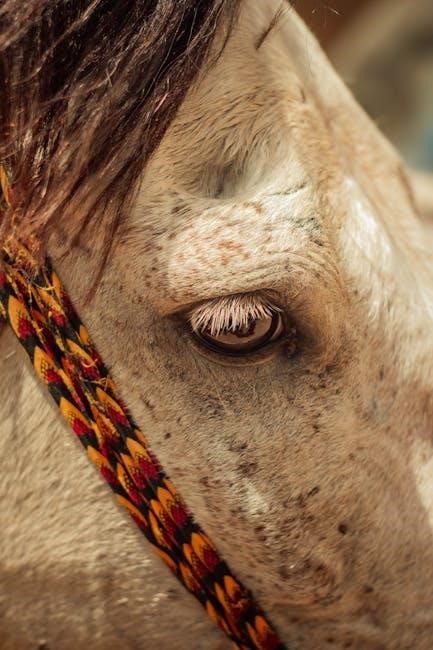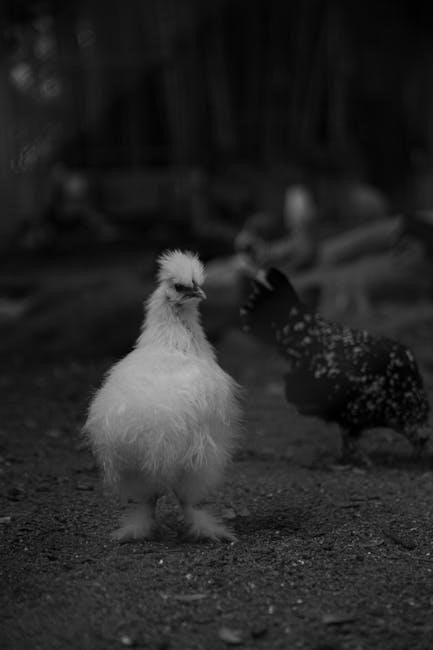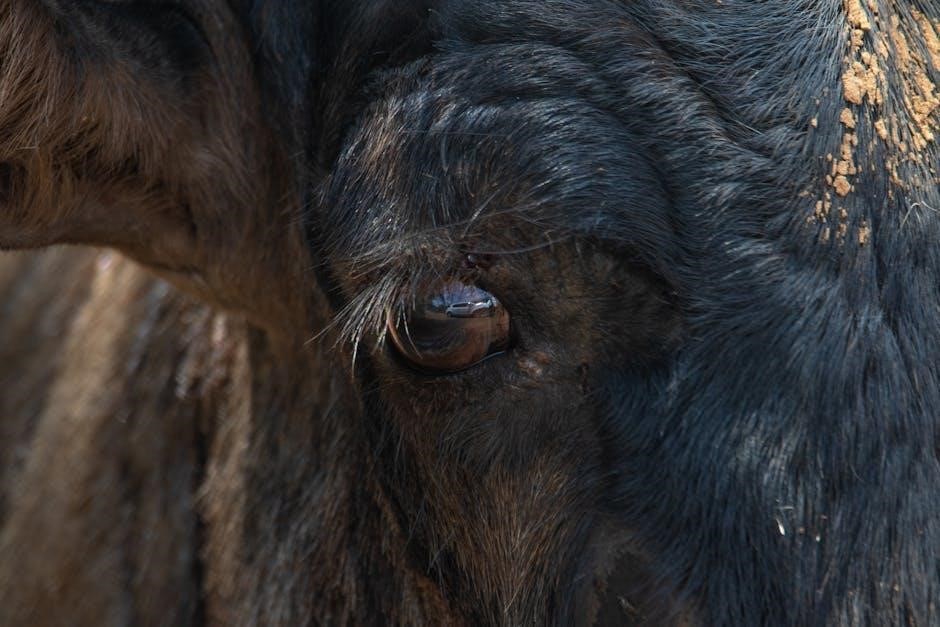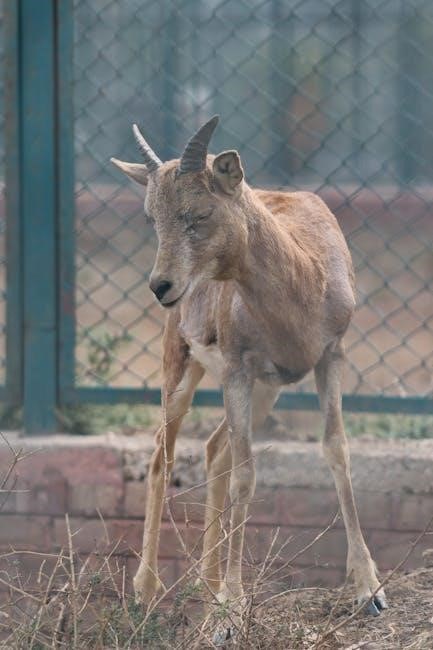George Orwell’s Animal Farm is a timeless allegorical novel exploring themes of power, corruption, and rebellion. Study guides and PDFs offer chapter-by-chapter analysis, questions, and answers, helping students grasp the novel’s deeper meanings, historical context, and symbolic elements, making it easier to understand Orwell’s critique of totalitarianism and its relevance today.
Overview of George Orwell’s Animal Farm
Animal Farm by George Orwell is a profound allegorical novella that depicts the events of the Russian Revolution through a barnyard setting. The story revolves around a group of animals who rebel against their oppressive owner, Mr. Jones, seeking freedom and equality. Led by the pigs, the animals establish their own government based on the principles of “Animalism.” However, the ideals of unity and fairness gradually erode as power corrupts the pigs, leading to a totalitarian regime. The novella explores themes of corruption, class struggle, and the manipulation of truth, offering a scathing critique of Stalinism and authoritarianism. Through its vivid characters and symbolic narrative, Animal Farm remains a timeless commentary on human nature and political systems, making it a cornerstone of literary and historical analysis.

Significance of the Novel as an Allegory
As an allegory, Animal Farm serves as a powerful tool for understanding complex historical and political concepts. By representing the Russian Revolution and Stalinist regime through animal characters, Orwell simplifies these events while maintaining their depth and complexity. This allegorical approach allows readers to dissect themes such as power corruption, class inequality, and the manipulation of truth in a more relatable and accessible manner. Study guides enhance this understanding by providing questions and answers that highlight the symbolic meanings of characters and events, enabling deeper analysis of Orwell’s critique of totalitarianism. The novel’s allegorical nature ensures its relevance across generations, making it a vital text for exploring the dynamics of authority and societal structures.
Historical Context and Inspiration
George Orwell drew inspiration from the Russian Revolution and its aftermath when writing Animal Farm. The novel parallels the rise of communism, the leadership of figures like Lenin and Stalin, and the eventual corruption of revolutionary ideals. Study guides highlight how characters like Napoleon and Snowball represent these historical figures, while events such as the Battle of the Cowshed reflect real battles like the Russian Civil War. Orwell’s critique of Stalinism and totalitarianism is central to the story, with the pigs symbolizing the ruling elite. PDF guides provide questions and answers that explore these connections, offering students a clearer understanding of the historical backdrop that shaped the novel’s themes and characters. This context is essential for grasping Orwell’s commentary on power and corruption.

Character Analysis
Napoleon, Snowball, and Boxer are central to the story, each representing distinct traits and ideologies. Study guides explore their roles, revealing how their actions shape the plot’s power dynamics and moral themes, while minor characters like Benjamin and Mollie add depth to the narrative, highlighting loyalty, skepticism, and betrayal, all crucial to understanding Orwell’s commentary on human nature and societal structures.
Major Characters: Roles and Significance
The major characters in Animal Farm are pivotal to the story’s allegorical depth. Napoleon, the power-hungry pig, embodies totalitarian leadership, manipulating others for control. Snowball, the idealistic revolutionary, represents the betrayed ideals of the rebellion. Boxer, the loyal and hardworking horse, symbolizes the exploited working class, whose dedication is taken advantage of by the corrupt regime. Benjamin, the wise old donkey, serves as the voice of skepticism and truth, while Mollie, the vain horse, represents self-interest and betrayal. Each character’s role highlights themes of power corruption, loyalty, and the consequences of unchecked ambition, making them essential to understanding Orwell’s critique of totalitarianism and human nature. Their actions and fates drive the narrative, illustrating the novel’s timeless relevance.
Minor Characters: Their Impact on the Plot
Minor characters in Animal Farm play crucial roles in advancing the plot and enriching the narrative. Mollie, the self-indulgent horse, symbolizes betrayal and the lure of luxury, while Benjamin, the wise donkey, serves as a voice of reason and skepticism. Clover, the kind-hearted mare, represents compassion and moral integrity, often acting as a mediator. Mr. Jones, the oppressive farmer, catalyzes the rebellion, setting the story in motion. Squealer, the manipulative pig, uses propaganda to justify Napoleon’s actions, highlighting the power of misinformation. Boxer, though a major character, also influences the plot through his unwavering dedication and tragic fate. These characters, though lesser in prominence, contribute significantly to the novel’s themes of corruption, rebellion, and the complexities of power dynamics, making their roles indispensable to the story’s depth and impact.
Psychological Insights into Animal Behavior
George Orwell’s Animal Farm offers profound psychological insights into how power dynamics, fear, and manipulation shape animal behavior. The pigs, particularly Napoleon and Snowball, exhibit leadership traits, using fear to maintain control and justify their actions. The animals’ conformity to the pigs’ rules highlights the psychological impact of authority and propaganda. Boxer’s unwavering loyalty and dedication illustrate the dangers of blind obedience, while Benjamin’s skepticism reflects the rarity of critical thinking. The novel explores how fear of punishment and the promise of stability lead animals to accept oppression. Additionally, the manipulation of truth through Squealer’s propaganda demonstrates how psychological control can distort reality. These insights mirror human behavior, emphasizing Orwell’s critique of totalitarianism and the vulnerability of individuals to psychological manipulation, making the novel a timeless study of power and its effects on collective and individual minds.

Thematic Analysis
Orwell’s Animal Farm explores themes of totalitarianism, power corruption, class struggle, and propaganda, offering timeless insights into how these forces shape societies and individuals, as study guides reveal.
Themes of Totalitarianism and Power Corruption
Orwell’s Animal Farm serves as a powerful critique of totalitarianism, illustrating how power corrupts even those with noble intentions. The pigs, led by Napoleon, gradually abuse their authority, mirroring historical dictatorships. Study guides highlight how the novel depicts the manipulation of ideals, such as Animalism, to justify oppression. Questions in these guides often focus on Napoleon’s tactics, like rewriting the Seven Commandments, to maintain control. The theme of power corruption is central, showing how leaders exploit fear and ignorance to dominate. PDF resources emphasize Orwell’s warning about the dangers of unchecked authority and the erosion of freedom. This theme remains relevant, encouraging readers to critically evaluate systems of power and their impact on society, as explored in depth through the novel’s allegorical lens.

The Concept of Animalism and Its Evolution
Animalism, introduced by Old Major, represents an idealistic philosophy advocating equality and freedom from human oppression. Study guides and PDFs explore how this concept evolves throughout the novel. Initially, Animalism unites the animals, inspiring rebellion against Mr. Jones. However, as the pigs gain power, the ideology is distorted to justify their dominance. Questions in these resources often examine how the pigs manipulate Animalism’s principles, leading to its gradual erosion. The evolution of Animalism reflects Orwell’s critique of how revolutionary ideals can be corrupted by those in power. PDF analyses highlight the transition from a collective movement to a tool of control, emphasizing the loss of the original vision and the animals’ eventual realization of their betrayal, as explored in depth through the novel’s allegorical lens.
Class Struggle and Social Hierarchy
In Animal Farm, class struggle and social hierarchy are central themes, reflecting the animals’ evolving relationships post-rebellion. Study guides and PDFs highlight how the pigs, led by Napoleon and Snowball, establish a new social order, with themselves at the top. Questions explore how the pigs manipulate the Seven Commandments to justify their dominance, while other animals, like Boxer and Clover, represent the exploited working class. The novel illustrates how power imbalances emerge even in supposedly egalitarian systems. PDF analyses emphasize the gradual division among the animals, as the pigs’ actions blur the lines between oppressors and oppressed. This mirrors real-world class struggles, offering insights into how hierarchies form and sustain themselves, as discussed in depth through chapter-specific questions and thematic explorations in study resources.
The Role of Propaganda in Shaping Reality
Propaganda plays a crucial role in Animal Farm, as it shapes the animals’ perceptions and maintains the pigs’ control. Study guides and PDFs highlight how Squealer, the pigs’ propagandist, manipulates language and facts to justify their actions. Questions in these resources explore how the pigs alter the Seven Commandments and use fear to consolidate power. For instance, Squealer’s justification of the pigs’ privileges, like sleeping in beds, illustrates how propaganda distorts reality. The novel shows how easily truth can be twisted to serve those in power, making the animals complicit in their own exploitation. PDF analyses emphasize the psychological impact of propaganda, as the animals increasingly accept the pigs’ narrative, even when it contradicts their own experiences, further solidifying the pigs’ authority and the collapse of rebellion.

Chapter-Wise Study Guide
Detailed PDF guides provide in-depth analysis of each chapter, offering questions and insights into key events, character development, and thematic elements, enhancing understanding of Orwell’s narrative.
In Chapter 1, Old Major, a wise and aged pig, gathers the animals to share his vision of a rebellion against Mr. Jones. He speaks of a utopian future where animals can live freely and equally, inspiring the others with his speech. The chapter introduces key characters like Boxer, Clover, and Benjamin, highlighting their roles and personalities. Study guides provide questions such as, “What is significant about how the animals arrange themselves?” and “Who did it seem the animals would support after Major’s speech?” These inquiries help students analyze the beginning of the rebellion and the seeds of division among the animals, setting the stage for the events that follow.
Chapter 2: The Development of Animalism
Chapter 2 explores the evolution of Animalism, a philosophy rooted in Old Major’s teachings. The pigs, led by Napoleon and Snowball, refine these ideas into a structured system of thought. They establish the Seven Commandments, which serve as the foundation for the new society. Study guides highlight how the pigs’ leadership begins to show signs of power dynamics, with questions like, “After Major’s death, what happens to the idea of rebelling against man?” and “How do the pigs convince the other animals of the principles of Animalism?” These questions emphasize the pigs’ role in shaping the rebellion and the early stages of their influence over the farm.
Chapter 3: The Struggle for Leadership
Chapter 3 delves into the emerging rivalry between Napoleon and Snowball as they vie for control of the farm. Study guides for this chapter include questions like, “Who did it seem the animals would support after Snowball’s speech at the Sunday windmill meeting?” This highlights the tension between the two leaders. The pigs’ leadership begins to fracture, with disagreements over strategy and governance. Questions such as “What were the animals promised?” and “Why did Napoleon begin executing animals?” provide insight into the power struggle and its impact on the farm’s unity. These inquiries help students understand the early signs of totalitarianism and the manipulation of power within the Animalist movement.
Chapter 4: The Battle of the Cowshed
Chapter 4 highlights the Battle of the Cowshed, a pivotal moment in the novel where the animals defend their farm against a human invasion. Study guides for this chapter include questions such as, “Who led the defense of the farm?” and “What role did Boxer play in the battle?” These inquiries emphasize the animals’ unity and determination to protect their home. The battle symbolizes the animals’ resilience and their commitment to the principles of Animalism. Questions like, “How did the animals react to their victory?” explore the emotional and psychological impact of the event. This chapter underscores themes of loyalty, sacrifice, and the early stages of power dynamics among the pigs, setting the stage for future conflicts.
Chapter 5: The Rise of Napoleon’s Tyranny
Chapter 5 marks the escalation of Napoleon’s power as he consolidates control over Animal Farm. Study guides highlight Napoleon’s strategic manipulation, such as his decision to sell timber to neighboring farms, which sparks controversy. Questions like, “Why did Napoleon expel Snowball?” and “How did the dogs enforce Napoleon’s rule?” reveal his authoritarian tactics. The chapter explores how fear and propaganda are used to maintain power, as seen when Napoleon accuses Snowball of sabotage. Boxer’s unwavering loyalty contrasts with the growing mistrust among other animals. This chapter underscores the corrupting influence of power and the erosion of Animalism’s original ideals. Study guides emphasize Napoleon’s manipulation of events to justify his dictatorship, showcasing Orwell’s critique of totalitarian leadership.
Chapter 6: The Betrayal and Consequences
Chapter 6 explores the betrayal of the animals’ trust as Napoleon’s tyranny intensifies. Study guides highlight Napoleon’s purges, where he executes animals accused of disloyalty, spreading fear and control. Questions such as, “Why did Napoleon begin executing animals?” and “How did Boxer react to these events?” reveal the psychological impact on the farm. The chapter underscores the manipulation of power, as Napoleon uses propaganda to justify his actions. Boxer’s unwavering loyalty, despite his confusion, contrasts with the growing despair among others. This section emphasizes the consequences of unchecked power and the erosion of the animals’ unity. Study guides also explore how Napoleon’s actions mirror historical dictatorships, reinforcing Orwell’s critique of authoritarianism and betrayal of ideals.
Chapter 7: The Final Collapse of the Rebellion
Chapter 7 marks the tragic end of the animals’ rebellion as the farm descends into chaos. Study guides delve into the collapse of Animalism, with questions like, “What led to the final breakdown of the rebellion?” and “How did the animals react to the loss of their ideals?” This chapter highlights the disillusionment of the animals, particularly Boxer’s tragic fate, symbolizing the exploitation of loyalty. The pigs, now indistinguishable from humans, completely abandon the Seven Commandments. The novel concludes with a sense of despair, as the animals realize their struggle for freedom and equality has failed. Study guides also explore the broader implications, linking the collapse to historical revolutions, emphasizing Orwell’s warning about the dangers of corruption and the loss of original ideals. The chapter serves as a poignant reminder of the cyclical nature of power and oppression.

Symbols and Metaphors
The farm symbolizes society, with animals representing different social classes. The pigs embody corrupt leadership, while the Seven Commandments metaphorically depict the erosion of ideals through power and manipulation.
The Significance of the Farm as a Symbol
The farm in Animal Farm serves as a microcosm of society, representing the broader human experience. It symbolizes any community striving for self-governance and equality, reflecting the challenges of maintaining ideals amidst power struggles. The transformation of the farm mirrors historical revolutions, where initial utopian goals devolve into corruption. The land itself becomes a character, enduring the rise and fall of leadership, illustrating how environments shape and are shaped by their inhabitants. This symbolism allows readers to draw parallels to real-world political movements, making the novel a powerful commentary on human nature and governance. The farm’s evolution from hope to tyranny underscores Orwell’s warning about the dangers of unchecked power.
The Role of the Seven Commandments
The Seven Commandments in Animal Farm are central to the animals’ rebellion, acting as a moral framework for their new society. These principles, derived from Old Major’s vision, aim to ensure equality and fairness among all animals; They are inscribed on the barn wall, serving as a constant reminder of the revolution’s goals. However, as the pigs consolidate power, the commandments are gradually altered, reflecting the corruption of the original ideals. This manipulation highlights the theme of power corrupting even the noblest intentions. The commandments evolve from a symbol of unity to a tool of control, demonstrating how language and principles can be distorted to justify tyranny. Their alteration mirrors real-world instances of ideology being twisted to maintain authority, making them a crucial element in Orwell’s critique of totalitarianism.
The Representation of Historical Events
George Orwell’s Animal Farm allegorically represents key historical events, particularly the Russian Revolution and its aftermath. The animals’ rebellion against Mr. Jones mirrors the overthrow of Tsar Nicholas II, while Napoleon and Snowball symbolize Stalin and Trotsky, respectively. The power struggle between them reflects the conflicts within the Communist Party. The Battle of the Cowshed represents the Russian Civil War, showcasing the animals’ initial unity and later divisions. Napoleon’s rise to tyranny parallels Stalin’s consolidation of power, including the Great Purge, as he eliminates dissenters. The manipulation of the Seven Commandments reflects how historical narratives are altered to justify authoritarian rule. Orwell’s depiction of these events critiques totalitarianism and the corruption of revolutionary ideals, offering a timeless commentary on political power and its abuses. The novel serves as a powerful lens to understand historical patterns and their enduring relevance.
Study Resources and References
Downloadable PDF study guides provide comprehensive chapter-by-chapter questions and answers, analysis, and insights into Animal Farm. Online resources offer additional materials, including discussion prompts and deeper thematic explorations, while suggested readings enhance understanding of Orwell’s allegorical masterpiece.
Recommended PDF Study Guides
For a deeper understanding of Animal Farm, various PDF study guides are available online, offering comprehensive analysis and chapter-by-chapter questions. These guides provide detailed summaries, thematic insights, and critical thinking exercises. LitCharts and other educational platforms offer downloadable resources that include answers to chapter questions, making them ideal for self-study. Additionally, guides like the “Animal Farm Study Guide Chapter I” by ТИ Кузнецова and similar resources offer structured formats for students to record their responses and reflections. These PDFs are invaluable for classroom discussions, homework, and exam preparation, ensuring a thorough grasp of Orwell’s allegorical masterpiece. They cater to diverse learning styles, making complex concepts accessible and engaging for all students.

Online Resources for Chapter Questions

Several online platforms offer extensive resources for Animal Farm chapter questions and answers. LitCharts provides a printable PDF guide, combining literary analysis with AI-driven insights to address chapter-specific queries. Educator websites and forums feature structured question sets, ideal for classroom use. Platforms like Google Classroom and Educator Resource hubs offer downloadable worksheets and discussion prompts; Additionally, websites such as Course Hero and Quizlet host user-contributed content, including chapter-by-chapter questions and answers. These resources are tailored for students seeking to deepen their understanding of Orwell’s allegory and prepare for exams or assignments. They cover themes, character analysis, and plot development, making them invaluable for both individual and group study.
Suggested Reading for Deeper Analysis
To enhance your understanding of Animal Farm, consider exploring additional literary critiques and analyses. Eric Arthur Blair’s biographies provide insights into Orwell’s motivations. Critical essays by scholars like Robert Pearce offer deeper exploration of the novel’s themes. The PDF guide from LitCharts is particularly useful, as it combines detailed summaries with thematic analyses. For a broader perspective, read works on the Russian Revolution, such as Richard Pipes’ A History of the Russian Revolution, to better grasp the allegorical connections. Additionally, essays on totalitarianism and its literary representations can enrich your analysis. These resources will help you interpret the novel’s complex layers and its enduring relevance to political and social discourse.
Orwell’s Animal Farm remains a powerful allegory, and study guides with questions and answers provide valuable insights. They aid in exploring themes, characters, and historical parallels, fostering deeper understanding and sparking discussions on power, corruption, and societal dynamics.
Final Thoughts on the Novel’s Relevance
George Orwell’s Animal Farm remains a timeless critique of power, corruption, and societal dynamics. Study guides with questions and answers enhance understanding, offering insights into themes like totalitarianism and class struggle; The novel’s allegorical nature allows readers to draw parallels with historical events, making it a vital tool for analyzing political and social systems. Its exploration of how power corrupts even the noblest ideals resonates universally, encouraging reflection on human nature and governance. The availability of PDF resources and chapter-wise analysis aids students in grasping these complexities, fostering critical thinking and deeper engagement with Orwell’s warnings about manipulation and control.

Encouragement for Independent Analysis
Engaging with Animal Farm through study guides and chapter questions fosters a deeper understanding of Orwell’s themes and allegories. While resources like PDFs provide valuable insights, readers are encouraged to explore beyond these materials, forming their own interpretations. Writing essays, participating in debates, or creating reflective projects can enhance critical thinking. Analyzing the novel’s portrayal of power dynamics, moral dilemmas, and societal structures encourages readers to draw connections to real-world events and personal experiences. Independent analysis allows for a richer comprehension of Orwell’s message, making the study of Animal Farm a rewarding and thought-provoking experience that extends beyond the classroom.

No Responses